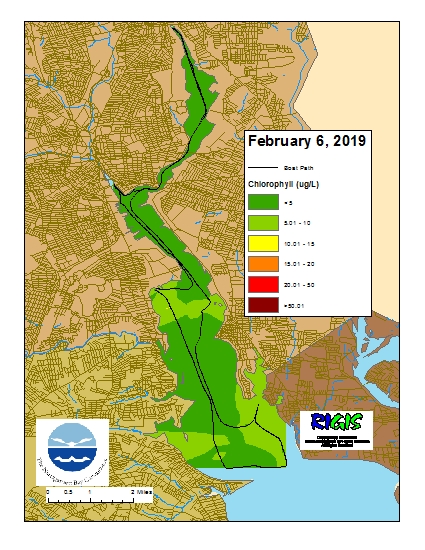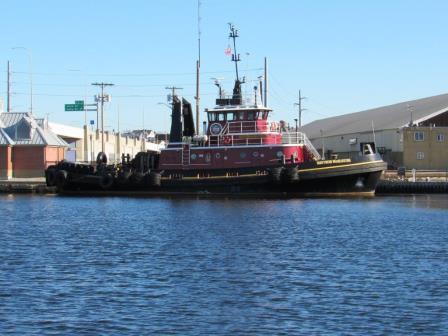Historical News
Surface Mapping
Data was collected on February 6, 2019 while the R/V Monitor was underway collecting bacteria samples. The chlorophyll concentrations were low to fair in areas surveyed. From north to south, average chlorophyll concentrations were as follows: Seekonk River (2.02 µg/l), Upper Providence River (3.41 µg/l), Edgewood Shoals area (6.72 µg/l), Pawtuxet River area (3.19 µg/l), and the Lower Providence River (5.42 µg/l). Overall, chlorophyll ranged between 0.50 µg/l and 14.30 µg/l with an overall average of 3.76 µg/l. The chlorophyll data from this date is presented in the map below:

Benthic Video Blog
The boat crew conducted benthic video surveys along the Bullock Reach, Edgewood, and Sabin transects on February 5th. Scale lasers were used in the footage, separated by 29 cm. Visibility through the water column was poor this week at all transects making fine-scale observations impossible. The bottom of all sites was characterized by sands and muds, with occasional boulders and cobbles, as well as sparse to dense shell hash and shell rubble (especially at Sabin). Algal coverage was diverse this week, all sites featured sparse Ulva, filamentous and branching algae (dominate at all transects), as well as sparse sheet-like red algae at Sabin and Bullock Reach; all sites also featured dense areas of diatom felt. General biotic activity was high as noted by extensive tracks and trails. Rare benthic video sights included horseshoe crabs at Sabin and Edgewood (photo below), as well as surfaced chaetopterid tubes at Bullock Reach and Sabin. Infaunal activity was moderate to high; large burrows, likely from mantis shrimp (Squilla), and many small burrows were present. Assemblages of small tube-building fauna and parchment worm (Chaetopterus) tube openings were also common at all sites but more frequent at Bullock Reach and Edgewood. Common observations consisted of Nassariid mudsnails, slipper snail Crepidula (Bullock Reach and Edgewood), ctenophores (all sites), spider crabs (Bullock Reach), hermit crabs (Sabin), and boring sponges (Bullock Reach). All sites also had leaf and stick debris; beverage bottles were also noted at Sabin and Edgewood. Amphipod tube mats were not observed.

R/V Monitor's Blog
After several weeks of inclement weather, the R/V Monitor was out on the upper Bay twice this week. First, on Tuesday, February 5th, the crew was out conducting underwater benthic video transects, to document how reduced nitrogen loadings to the upper Bay impacts the local benthos. Three transects, using an underwater video camera mounted on a sled, were conducted this day. Jeff captained the boat, while monitoring professionals Gerard, Bekki, and Amanda worked the video equipment. It was a partly sunny day, warm and little wind. The waters were calm, ideal conditions to conduct the transect monitoring. Again, on Wednesday, February 6th, the crew was out collecting bacteria samples, taking Secchi Disk and Par sensor water clarity measurements, conducting water column profiles using the Seabird instrument, and conducting real-time surface mapping of water quality parameters, including dissolved oxygen, chlorophyll, water temperature, salinity and pH, all in an effort to document water quality improvements associated with NBC construction projects. Jeff captained the boat while monitoring professionals Amanda and Gerard collected the samples and data. It was a sunny but brisk day, and the wind and water were calm. Below is a photo taken on February 6th of a tug boat in the upper Bay.

Bacteria Sampling
Water Column Clarity
Water clarity was measured by Secchi disk at six locations on January 9, 2019. Very light rainfall of approximately 0.13 inches was recorded in the three days prior to the survey, and clarity overall was very similar to the previous week. The highest water clarity, 3.50 m, was measured at Edgewood Yacht Club; the lowest clarity, 1.70 m, was measured at Point St. Bridge. Overall clarity averaged 2.74 m across sites, compared to 2.56 m last week, with approximately half of sites exhibiting an increase and half exhibiting a decrease since the previous survey. There was a weak gradient in increasing clarity with distance down bay.


